The one hundredth anniversary of the Christmas Conference at the Goetheanum—a personal report.
The Goetheanum issued an invitation to the anniversary conference, and 1000 people from 40 countries came. It is my task to report here on lectures, discussions, and impulses so that conference guests will recognise something and others will gain an impression. The fact that I write from my personal perspective and place my thoughts alongside those of the speakers is not how it’s usually done, but I think it is more authentic. Objectivity is neither possible nor worth striving for here. Following Beuys, I show “my wound”: as a person who is actually rather more exoterically inclined, and yet a member of the School, I exposed myself over several days to a deeply esoteric atmosphere and tried to learn: What do I understand, what irritates me, where do I see beginnings and progressive impulses? What excites and inspires me? The following is deliberately not a summary of the presentations but a reflection and feedback.
Over five days, I witnessed concentrated communal work in the best School tradition: tangible wrestling in soul and spirit. Repeatedly, contributors made reference to the centrepiece of the conference: the Foundation Stone Meditation. The three-step process of “spirit recollection”, spirit contemplation”, and “spirit beholding” encourages us to search for truth and wisdom in the past, present and future. This aspiration was realised energetically, enthusiastically, and also self-critically in a wide variety of ways. Dozens of promising questions were asked, and the decisive and explosive question for me actually came from someone other than the speakers five minutes before the end of the conference. But more on that later!
Spirit Recollection: a Celebration
It begins with a celebration: the performance of the first part of Bach’s “Christmas Oratorio” on December 26. And so it is fitting that Justus Wittich’s first words the following morning are filled with “rejoicing and exultation”. The Anthroposophical Society in Switzerland, along with the Goetheanum Leadership, played a decisive role in the organisation of this conference in a thoroughly holistic way: not only is the Swiss accent represented on stage more often than at other international events, but Clara Steinemann also takes the trouble to fill out all the certificates of attendance by hand. In a courageous contribution on the implementation of anthroposophical ideas in economic life, Marc Desaules tells the audience that the amount needed to cover the costs was published in advance so participants would then be allowed to decide for themselves what matched their financial means. The Swiss Society undertook to bear any deficit. That’s also how it turned out: around CHF 100 per guest was missing. A failed experiment or a meaningful demonstration of the challenges we face if we want to take Steiner’s ideas seriously? It is impressive to see how down-to-earth idealists set a good example here in an open-minded and humorous way.
Every morning begins with a demonstration of the Foundation Stone Meditation: ensembles from different countries take up motifs and elements of language and sound from the four stanzas of the verse and bring the common content and linguistic differences to life in exercises. The verse is then performed in its entirety in German, Russian, English and Italian. I have a sense that this way of teaching makes eurythmy accessible to me in a more holistic way: the otherwise more intuitive experience of the space also becomes cognitive. I am invited to feel, move, and think along. With each repetition of individual passages, new aspects become visible—an encouraging kind of resonance. All of the groups are excellently prepared: their choice of symptomatic movement and sound elements opens windows that reveal more than just a “different” approach to the content. Eurythmy as visible language reveals delicate, respectful insights into the “objective spirit soul” of those doing eurythmy. Invited to let the German “Menschenseele” (“e” four times) resonate alongside the English “human soul” or the Italian “anima del’uomo”, my soul grows and expands.
How it Comes Across to Me
It has been pointed out many times in this publication and in lectures that the second century of anthroposophy will place new demands on us. Martin Buber’s approach of understanding our own I by approaching the Thou of the other is often quoted here. I understand this to mean that I am not guided by the “intent” but by the “effect” of my impulses. If a person only speaks because they want to say something, they remain with themselves. If they ask, “What would benefit the other person now?” they speak differently and learn valuable things about themselves. Rik ten Cate, general secretary of the Dutch society, whose contributions to this conference will be reported on in greater detail later, emphasises: “How can I help you?” is a completely different gesture from “I can help you!”. If I tell another person, “That’s how it came across to me”, neither they nor I will be helped if they respond with, “That’s not how I meant it”. This answer ends a process before it has begun and from which we could both learn. So this is how I would ask you to take it when, in the following paragraphs, I make a questioning or critical assessment of one or the other experience: this is how it came across to me.
On the first morning, following the eurythmy, Brigitte Kowarik reads the text of Rudolf Steiner’s founding address from 1923. Steiner had spoken in the freezing cold, draughty Schreinerei in front of hundreds of people—many standing or balancing on windowsills and scaffolding. We sit here comfortably in the warmth, borne along by the technically amplified voice of a trained speaker. I feel bourgeois and can’t connect with the words. What is missing? It’s Steiner speaking himself! But although I am wide awake, I am in a dream like a seven-year-old child being read a sweet-sounding fairy tale. It only becomes clear with the next speaker: Joan Melé, general secretary from Spain, quotes from the same address. Here, the words seem powerful and passionate, even though I don’t understand Spanish very well. I realise it’s because of his intent! Steiner had spoken from the bottom of his heart. The listeners sensed this, and for a while, the uncomfortable conditions were forgotten. Without this passion, without personal concern, Steiner’s words also lack something crucial. The experience makes me realise how important it is not only to receive anthroposophical content, but also to think about it and take it further. In this way, I can make it my concern and help it achieve authenticity.
Joan Melé describes how he used to visit Rudolf Steiner’s grave during his visits to the Goetheanum and ask for forgiveness for not being up to his task. “We were called but not chosen. The subsequent development has shown this,” he quotes Marie Steiner. Does this give rise to an aspiration for the second century of anthroposophy, or should we forgive ourselves for our imperfections? I have to think about the wound again … Melé (interpreted by Constanza Kaliks) speaks about the destiny that connects people working in anthroposophy: it can motivate us and foster our capacity for community. He is not the only speaker in these days to see the process not only in terms of inner work and solitary study but also pleads for external engagement—a guiding principle of the conference.
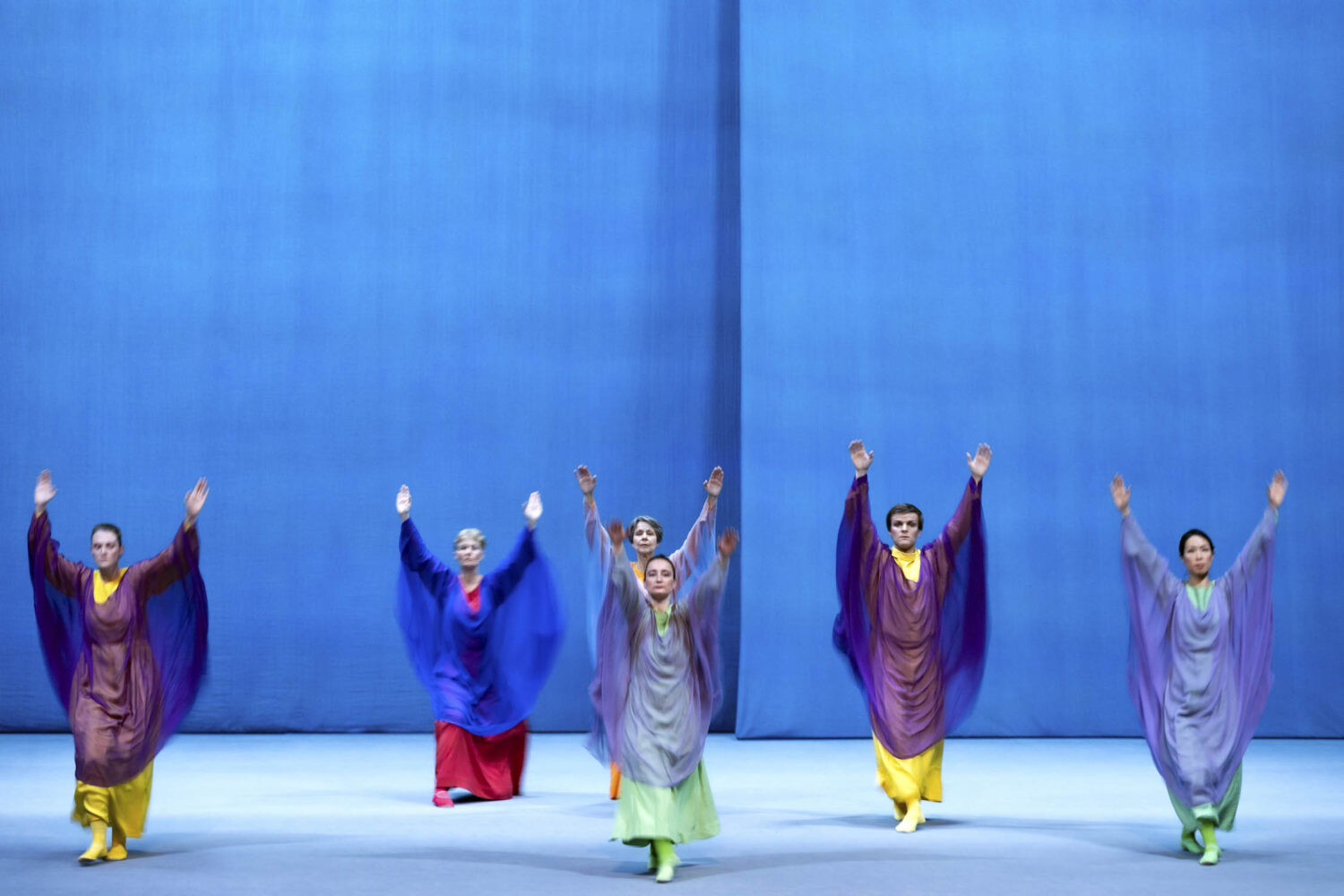
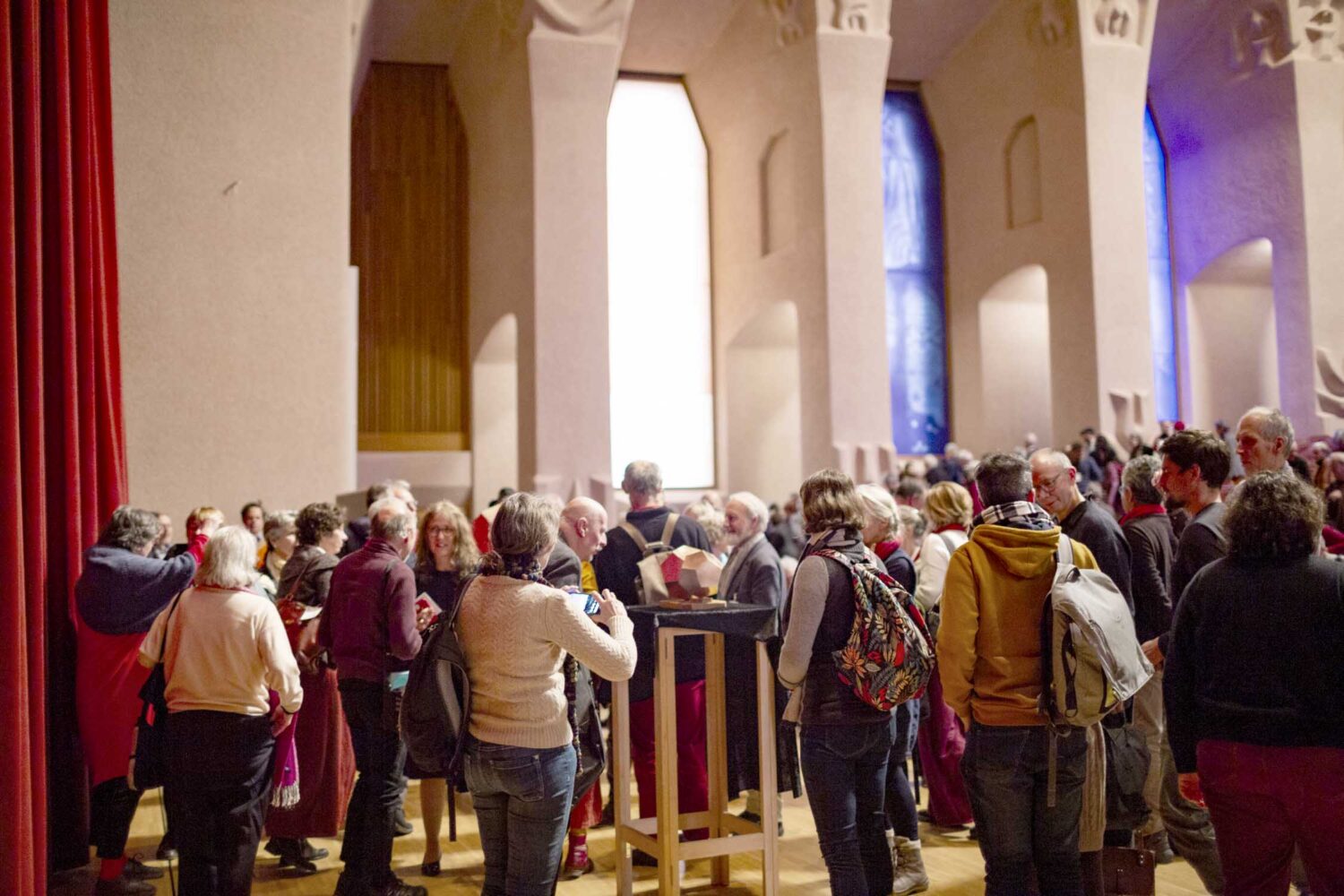

Left and top right: Photo: Ariel Turner; right: Photo: Xue Li
Spirit Contemplation: This Is How We Became – How Is It with Us?
In his article for the Weekly,1 Espen Tharaldsen identifies three modes of action of anthroposophy in its first incarnation: the “theosophical period” was primarily directed at thinking, through writings and lectures. Human feeling was stimulated by the development of the arts: eurythmy, drama, and architecture. Finally, the first Goetheanum presented itself to the world as an expression of the movement’s will, as a “signpost towards inner training”. The second Goetheanum is more orientated towards the world as a centre for research and for the practical and social implementation of anthroposophy. In the ideal “third Goetheanum” that Tharaldsen dreams of, education, research, and global impact are combined to create something new. In some places, the anniversary conference gives me an idea of how this could happen. The surprising final thought mentioned at the beginning will get to the heart of the matter.
Firstly, though, we look back a long way: Peter Selg talks about Ephesus, the oldest and easternmost mystery site in Greece. Referring to Ita Wegman, he describes in detail how visits to the temple might have taken place at that time, how people travelling along dark forest paths towards this wonder of the world found “indescribable joy” there, “a place of consecration for the living.” References to the anthroposophical movement kept flashing up during Selg’s lecture: the destruction of the temple through arson, the conversations between pupils and teachers during “evening walks,” and the temple servant “Mysa.”
Legend has it that Ephesus went up in fire that night in 356 BCE when Alexander first saw the light of day in Macedonia. This is where karmic threads connect and unravel and present us with riddles: can the first Goetheanum be seen as a new incarnation of the Temple of Artemis? There is a noticeable development here: there the wooden statue of Artemis, in the Goetheanum the equally westward-looking representative of humanity, embodying Steiner’s early motto: “In God’s place, the free human being.” And yet, weren’t the first people associated with anthroposophy still inward-looking, cultivating a kind of spiritual elitism like their Greek predecessors? Steiner struggled for a long time for real insight into the meaning of the Goetheanum fire, trying to see the “Logos in the scorching fire.” Was this sacrifice necessary to free anthroposophy from the Greek mystery traditions, the spirit of which can still be strongly felt in Steiner’s dramas? If the gesture in the wooden building was inner training, the current Goetheanum is the home of the School: a different gesture to which Selg devotes himself in his second conference contribution, in which he describes the School of Chartres.
After the Church had initially taken up the Christ impulse, he explains, it moved away again from 333 onwards by prioritising the celebration of the birth of “Jesus”: worship of the sun spirit gives way to that of the vessel in which it is to incarnate. A setback for Christian esotericism from which it would not recover for centuries. It is not until the turn of the millennium that Platonic souls are found in Western Europe who “in dreaming, explore the universe” and then begin to teach and exchange ideas. Very few of them were even active in Chartres, the location, but everywhere in Western Europe: unlike the temple at Ephesus, it was an ideational centre where Platonists came together to lay the foundations of modern science. Peter Selg describes it as a “school of thinking” and outlines how Aristotelian traits emerged through Arab-influenced Spain and found their way in. The Chartres scholar Alan de Lille characterises being human as our ability to adopt a meta-perspective: “A human being is someone who searches within themselves—someone who reads their life.”
This makes me think of Christian Morgenstern’s beautiful words: “To step back from ourselves like a painter from his picture—who could do that!” Here, as there, it is not just the analytical view but the love of what we behold that makes us fit for the future. Chartres was, therefore, a school, an impulse of cognition, but, according to Selg, a “cognition that goes to the heart”. Quoting Rudolf Steiner, he describes how between the death of Alan (1203) and the birth of Thomas Aquinas (1225), a kind of heavenly council took place, a harmonious handover between Platonism and Aristotelianism. Alan said, “The time of faith is ending. What is coming is the high age of science as the path to a future knowledge of the spirit.” Now it was the task of anthroposophy to turn science back into art: Selg called for a Platonic Aristotelianism in the age of Michael.

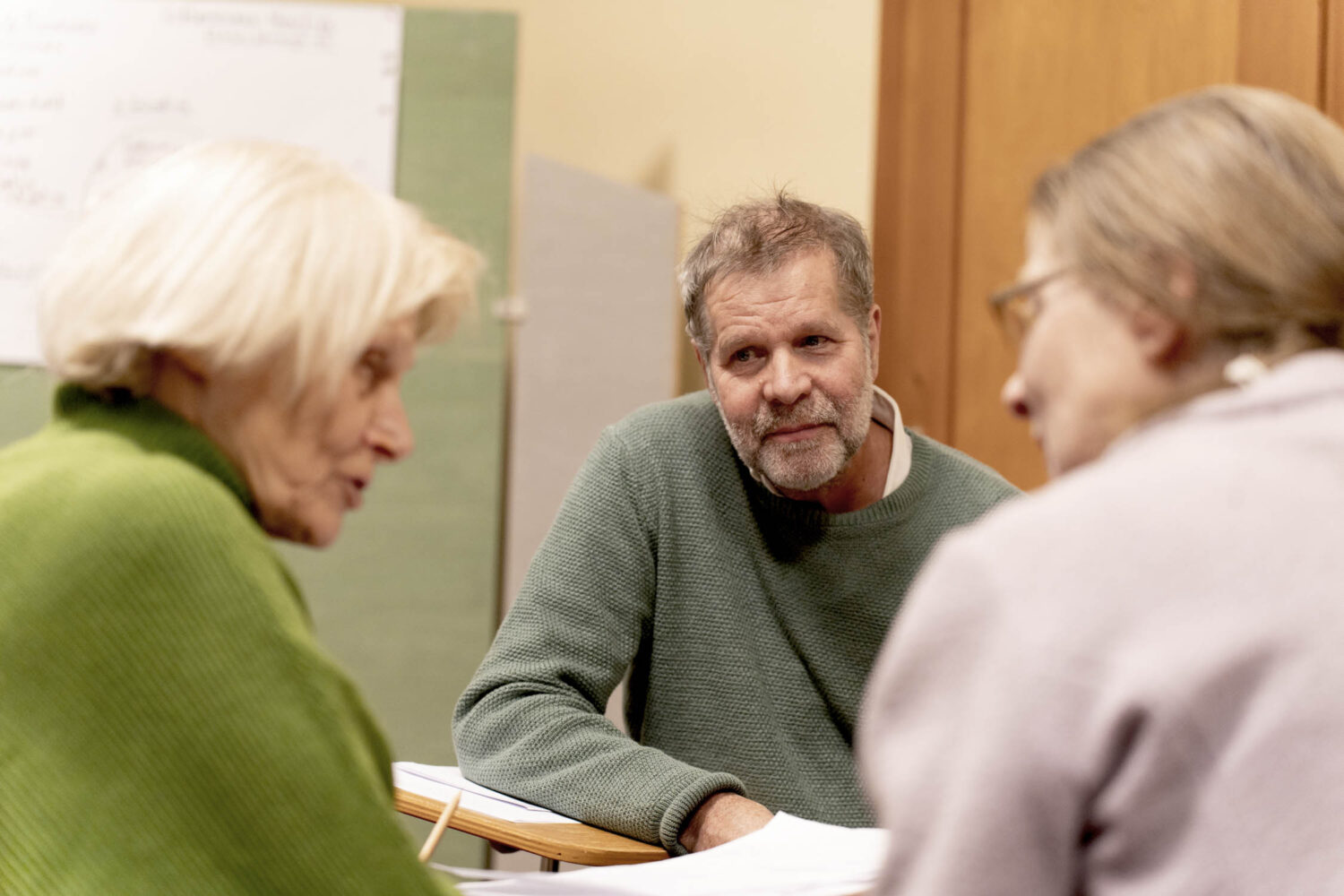
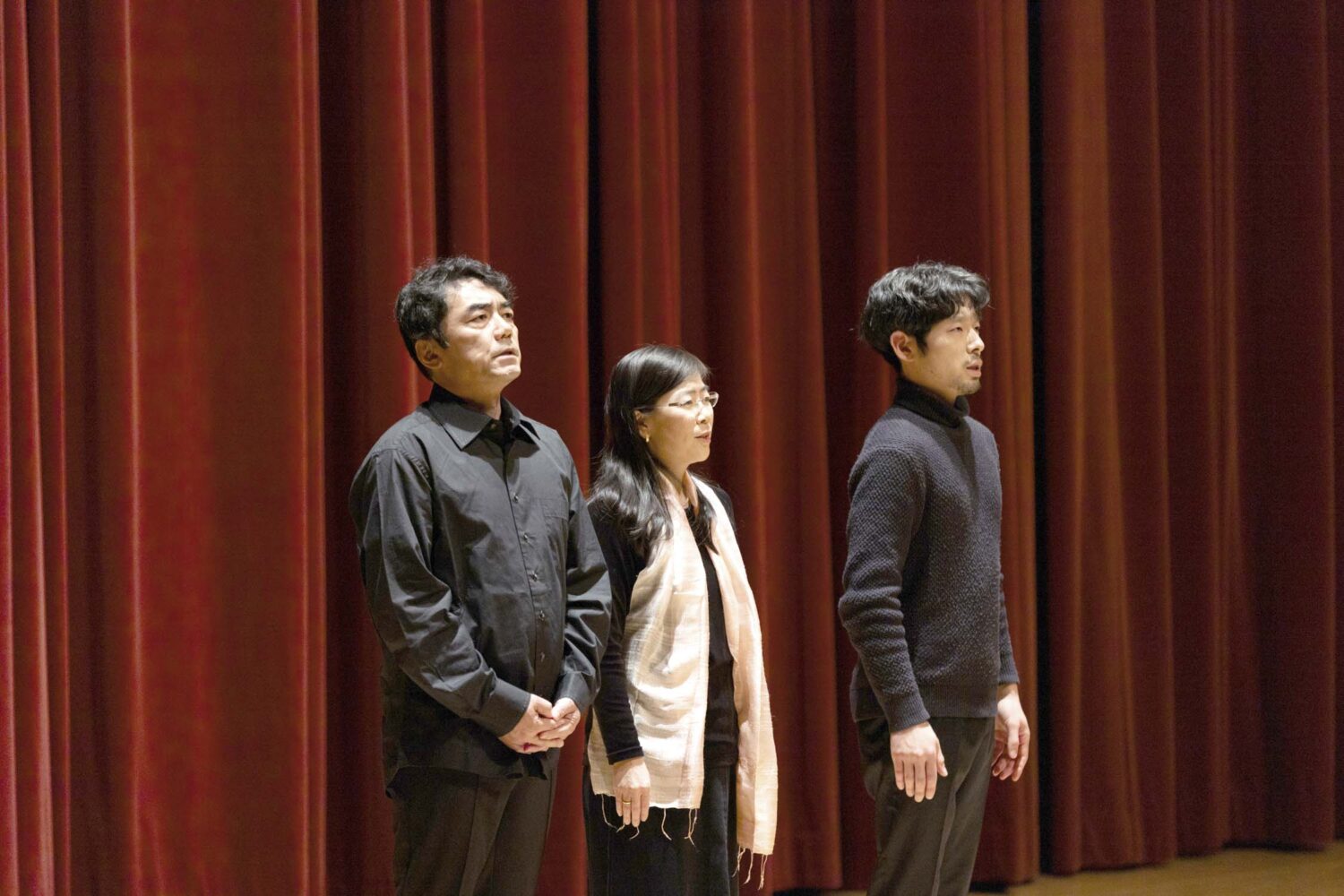
Left: Photo: Ariel Turner; top right: Benno Otter, Photo: Xue Li; bottom right: Fourth verse of the foundation stone saying in Japanese, Photo: Ariel Turner
The Warmth Column
A few hours earlier, Dutch anthroposophists Rik ten Cate and Pim Blomaard set the tone for the conference. Entering the stage from two sides in the style of the Oberufer shepherds, they compare the laying of the foundation stone by Rudolf Steiner in 1913 with the installation of a light column, which is still present in the second Goetheanum building—after all, it stands on the foundations of the first. But now, they argue, a “warmth column” is needed to support the light in its action. They recall Willem Zeylmans van Emmichoven, who experienced the Christmas Conference of 1923 as his spiritual rebirth and identified five qualities that had a decisive influence on anthroposophy: Sophia is supported by Michael and Zarathustra on the one hand and by Buddha and Nathan on the other.
Like Peter Selg later on, both speakers point out that spiritual science emphasises the left-hand side: the Aristotelian light of “correct thinking”. It must be joined by the right-hand side and given a little more weight at the beginning of the second century: “healthful feeling”. Rik ten Cate mentions the 40,000 members of the Anthroposophical Society: are they actually tangible at the centre? Sitting in the main auditorium, how aware am I of the people in Iceland, Peru, and Tanzania? He sees a lot of light in the Society: “Old white men give clever lectures and write learned books!” – the Michael/Zarathustra side of the diagram. How does the warmth side come into play here? How does it gain weight? Ten Cate asks: Where does anthroposophy touch me? Can I feel it physically? What would I have become without this touch? When I imagine a life “without”, I develop a different perspective on everything that I would cognitively see rather critically: now my heart sees with me!
The two speakers then unveil the Dutch Society’s anniversary gift to the birthday child: two beautiful double dodecahedrons modelled on the foundation stone of the Goetheanum, created in copper by ten Cate. One is for the existing building, as a reminder of the founding impulse. The other, smaller one, goes to the periphery: anthroposophical groups can borrow it for events, celebrations, and conferences and undertake to send it to the next borrower, no matter where in the world they are located. Rik ten Cate will organise its travels. The two parts of this structure are in a ratio of 1: 1.61 to each other (the golden ratio) and are thus reminiscent of the asymmetrical sides of the human heart and the cupolas of the first building. Thus, the Goetheanum welcomes two hearts: one beats “at home” in Dornach, where we meet and learn from each other, and the other is where the members are: in the world, constantly travelling in an “external home”. Where is the centre and the periphery of the movement and its society? Do we really need to answer this question definitively? In this beautiful gift, pointing the way to the future, studied and lived anthroposophy complement each other, point and periphery, teaching and field of life exist in dynamic coexistence.
The Light Column
An Apollonian light shines every morning when Matthias Girke examines the rhythms of the Foundation Stone Meditation. Always returning to the invitation to recollect, contemplate, and behold, and emphasising the elements of the past, present and future, he also sees “guiding stars for work on biography” here: what do we ourselves bring with us in terms of life impulses? Do we incorporate them into our work? Spirit recollection is also I-recollection, urges Girke. Do we have an awareness of the destiny that unfolds in our daily activities? Do our questions lead into the future through the will? According to Rudolf Steiner, moral values are linked to forces of becoming. It is no coincidence that the last sentence of the Foundation Stone Meditation begins with the words: “That good may become …”
Ideals are deeds of becoming, “deeds of human becoming”. As these ideals are longed for by the outside world, they are even “deeds of world becoming”. Are we open to recognising what the world needs from us? Do we hear its questions? I am impressed by the way Matthias Girke enters the stage. He doesn’t start straight away but stands quietly, his gaze roaming, taking in the participants as if inhaling, before he greets us. Sometimes he says “Dear attendees!” but mostly “Dear friends!” [using the common masculine form in German]. Many of the lectures this week begin like this. I’ve noticed this since I became sensitive to these things through my work because it linguistically excludes those people in the room who are not male. It can, of course, be argued (and many speakers defend their choice of language in this way) that “friends” includes non-male people. What would it be like if a speaker began a lecture in a packed hall with “Gentlemen” even though three-quarters of the seats were occupied by women? Would anyone complain? And would the argument that the ladies were also included be acceptable? I don’t really see much difference between “gentlemen” and “friends”, and I think we still have a lot to learn. On stage, an anthroposophical professor talks about “a girl who is doing her master’s degree with me”, presumably not realising that he is reducing the student to a child. How long will it take for listeners at the Goetheanum too to stand up and demand equal, non-degrading, and non-exclusionary language? We “old white men” (thank you, Rik ten Cate, I am one too!) would owe a debt of gratitude to such courageous people because we can learn the future from them. This is how (among other things) I see spirit beholding, as a mandate for mindfulness and as an expression of will.
In her contribution, Constanza Kaliks celebrates the achievements of the School: how much has it accomplished in its one hundred years! Measured against the developmental rhythms of other cultural impulses, anthroposophy is still young, but “anthroposophical science is so vigorous that it is already effective at the moment of its birth!” Thousands of Waldorf institutions, biodynamic farms, and hospitals owe their creation and existence to the research work and impetus of the School’s sections. The quote from Cusanus chosen by Kaliks has a lasting effect here: “Without longing, the spirit has no cognition, and without cognition, it has no longing.” The spirit longs for the world. Rudolf Steiner, and through him, the Anthroposophical Society, heard this call of modernity. People do research out of longing, not for fame or profit. An impressive heroine of the pioneering era of this impulse was Lili Kolisko, a widow living in meagre circumstances and excluded from the Society she loved, who researched the efficacy of potentised substances using the capillary dynamolysis method.
Constanza Kaliks also quotes Aristotle, “All people by nature strive for knowledge!” and links this sentence to Cusanus’ concept of spiritual longing. Steiner also sees “abilities in every human being through which they can acquire knowledge of the higher worlds.” Kaliks recalls that Steiner felt that the four Cartesian rules for finding the truth were insufficient but that they could be transformed. She concludes her lecture with Rudolf Steiner: “It is about seeing the embryonic life of a new spirituality in the envelope of a scientific way of conception. My opinion, based on observation of the matter, must be that the scientific path that modern humanity has taken, if it is understood correctly, is not an erroneous one but a correct one and that, if it is viewed correctly, it carries within it the seeds of a new cognition of the spirit and a new spiritual activity of the will. And it is this seed […] that this School of Spiritual Science stands for today, with great gratitude that there is a society that makes it possible.”
In addition to the “big lectures” and the contributions of the leading personalities at the Goetheanum, the conference also gives others the opportunity to voice their questions and opinions. When this happens from the audience, it is repeatedly unsatisfactory: the often nervous speakers seldom succeed in capturing the mood or even the approval of 1000 people with their concerns—this requires patience and inner interest from the listeners. For me, the main auditorium is not suitable for this kind of dialogue. Instead of providing people with an oversized forum for self-expression, the panel should provide impulse questions that can then be discussed with the people sitting next to you. This would give all participants the opportunity to discover new perspectives through others and to be heard themselves.

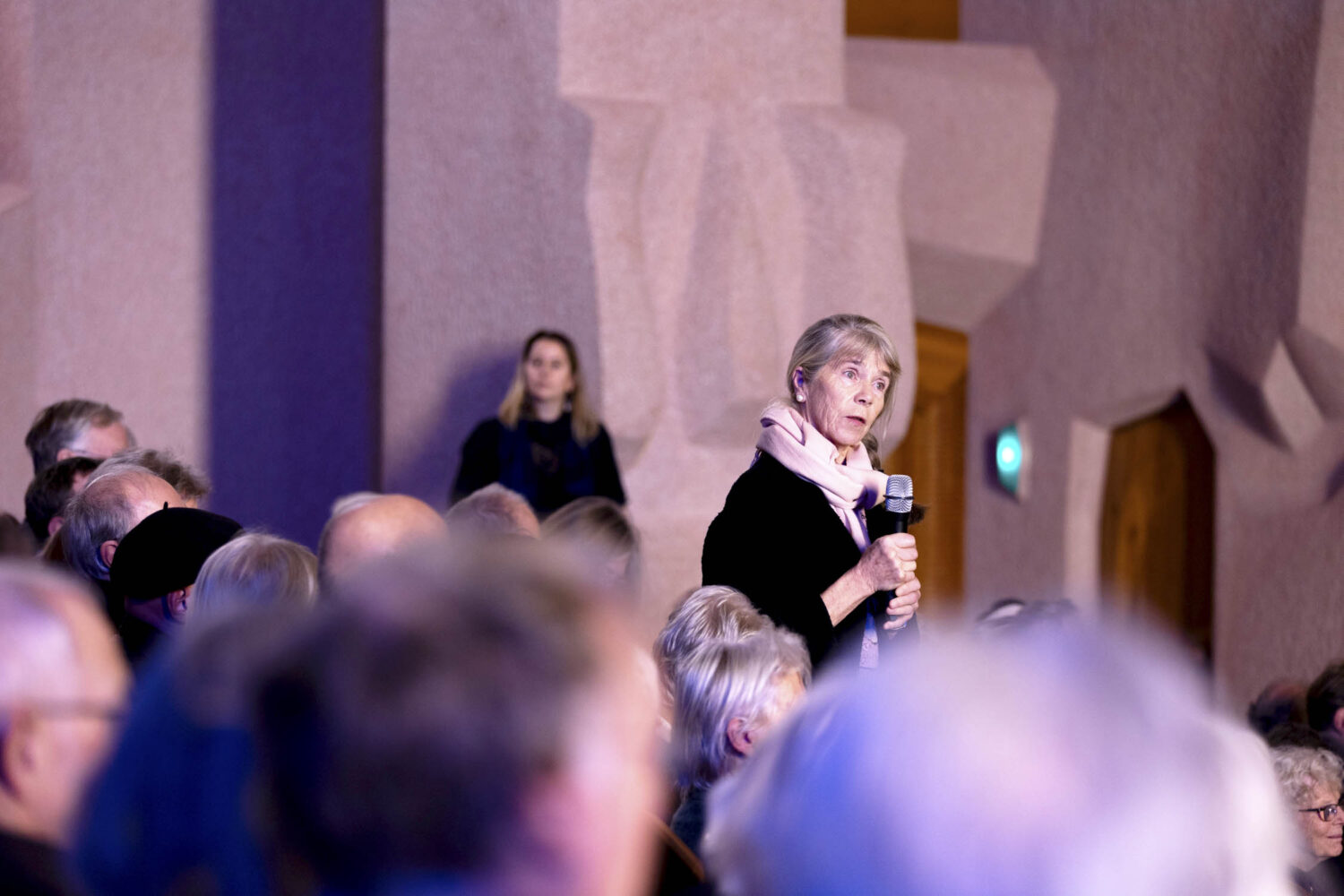
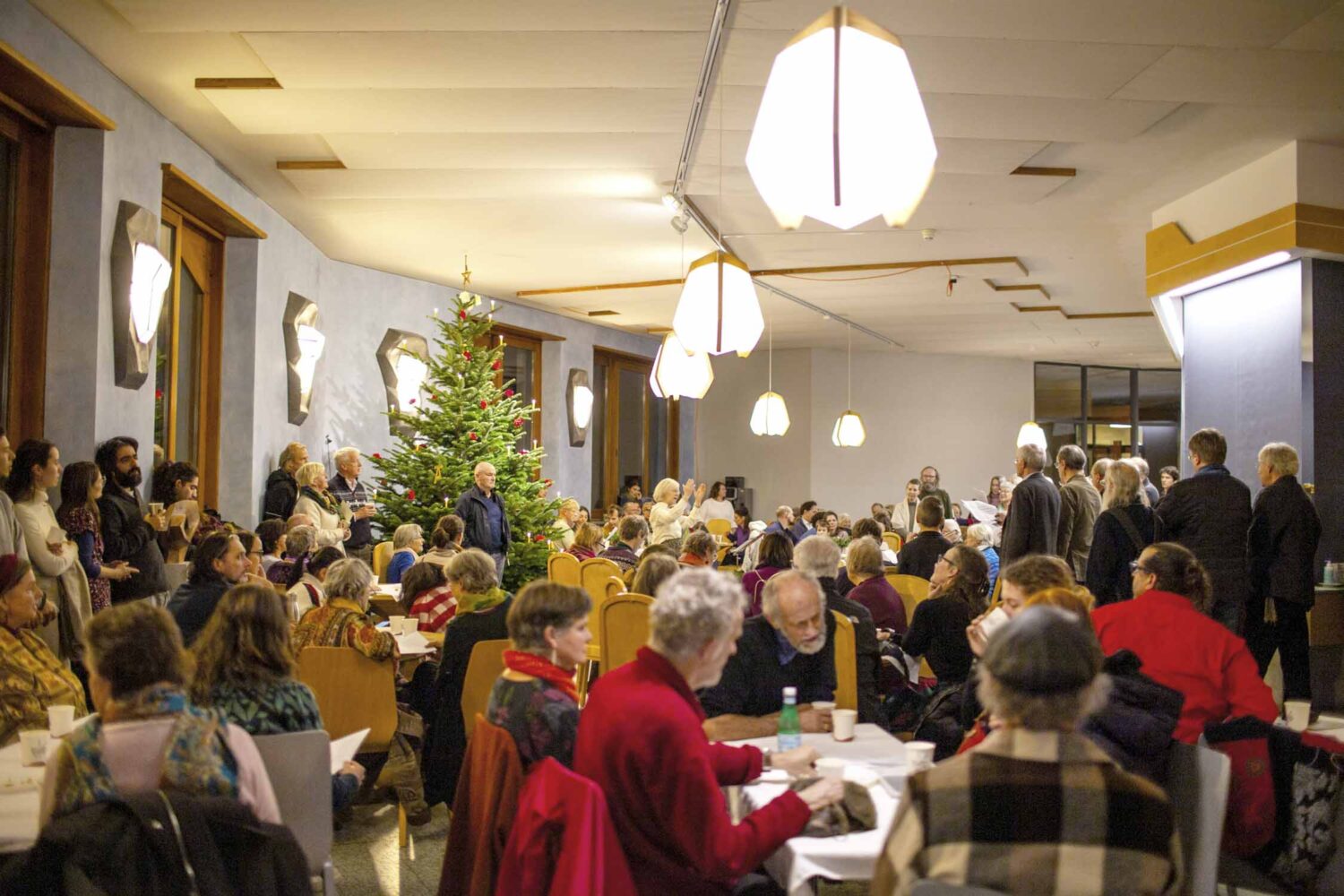
Left: Arzu Duran, Photo: Ariel Turner; Right: Photos: Ariel Turner
Spirit Beholding: What Wants to be Made Reality?
Of the “small panel contributions,” I recall the words of the British doctor James Dyson. He describes himself as “searching for a long time” for something that he could not find in anthroposophical culture. Finally, he discovers it in the approaches of Karl König and Bernard Lievegoed: the Buddha/Nathan side of the five-pointed star. The medical movement was born with a mission to “do good.” Does this apply to all areas of life, or are we still stuck in Aristotelianism? Dyson quotes Lievegoed: “Knowing the right thing is different from doing good!” He concludes with the open question of how we might succeed in overcoming the Platonic-Aristotelian divide and in giving equal space to light and warmth.
It occurs to me that one answer came from Steiner himself: in the autumn of 1922, he gave a group of young anthroposophists in Germany a daily meditation to help them feel connected to each other and to the spiritual world. This was the beginning of the “Esoteric Youth Circle,” to which many people active in anthroposophy belong. In this meditation, Steiner suggests “bringing warmth into the thinking and light into the heart”—in other words, in contrast to the shepherd/king polarity of the Foundation Stone Meditation.
On the third evening of the conference, Christine Gruwez describes the Rosicrucian impulse. She begins with words of thanks to the interpreters and, at the end of her lecture, also asks the listeners to wait with applause until they have translated her words into the other languages. In this modest and impressive way, she emphasises an essential element of Rosicrucianism: its action in the world. “Once something has been translated, it can no longer be eliminated from the world,” says Constanza Kaliks, quoting the German philosopher Franz Rosenzweig. This is in line with my opening thoughts: a modern impulse no longer takes its cue from the speaker’s need to send a message but from the effect that their words have.
Gruwez describes the detachment of spiritual impulses from locality: cognition was a temple experience in Ephesus, it was oriented around a centre in Chartres, and it freed itself from the attachment to place in the Rosicrucian impulse of the thirteenth and fourteenth centuries. Like Kaliks, she talks of the soul’s longing for knowledge and also identifies its endeavour: recognising the “essence” that lies on the boundary between physical and etheric substance. This never shows itself in its materiality but only in its effect and, therefore, cannot be recognised with earthly organs—and yet it is contained in all substance. The initiation of the Rosicrucian fraternity creates what Gruwez calls a “new physicality”: the basis for the ability to have boundary experiences. During her lecture, the question arises in my mind as to how “globally” this impulse was perceived in the Middle Ages and is perceived in modern times: European spiritual life is undoubtedly significantly shaped by it. But how does it work in the intuitive spiritual sensibility of the “Dreaming” of the Australian aborigines? What influence did it have on Inca culture in South America, which was flourishing at exactly the same time? When Rudolf Steiner and those who followed him speak of “humanity”, does this include all cultural impulses on earth or is a European “dominant culture” still assumed?
The Rosicrucian impulse strives for the joint transformation of the earth and human beings, the development of effective moral forces. Where does it live today, and is it to be understood as an inner mission? Is the modern human being’s proximity to the threshold responsible for the fact that the boundary between the physical and the etheric is threatening to disappear? Christine Gruwez brings up the shepherds who know how to protect these endangered forces. Can we take on the task of shepherding, the oldest task of humanity?
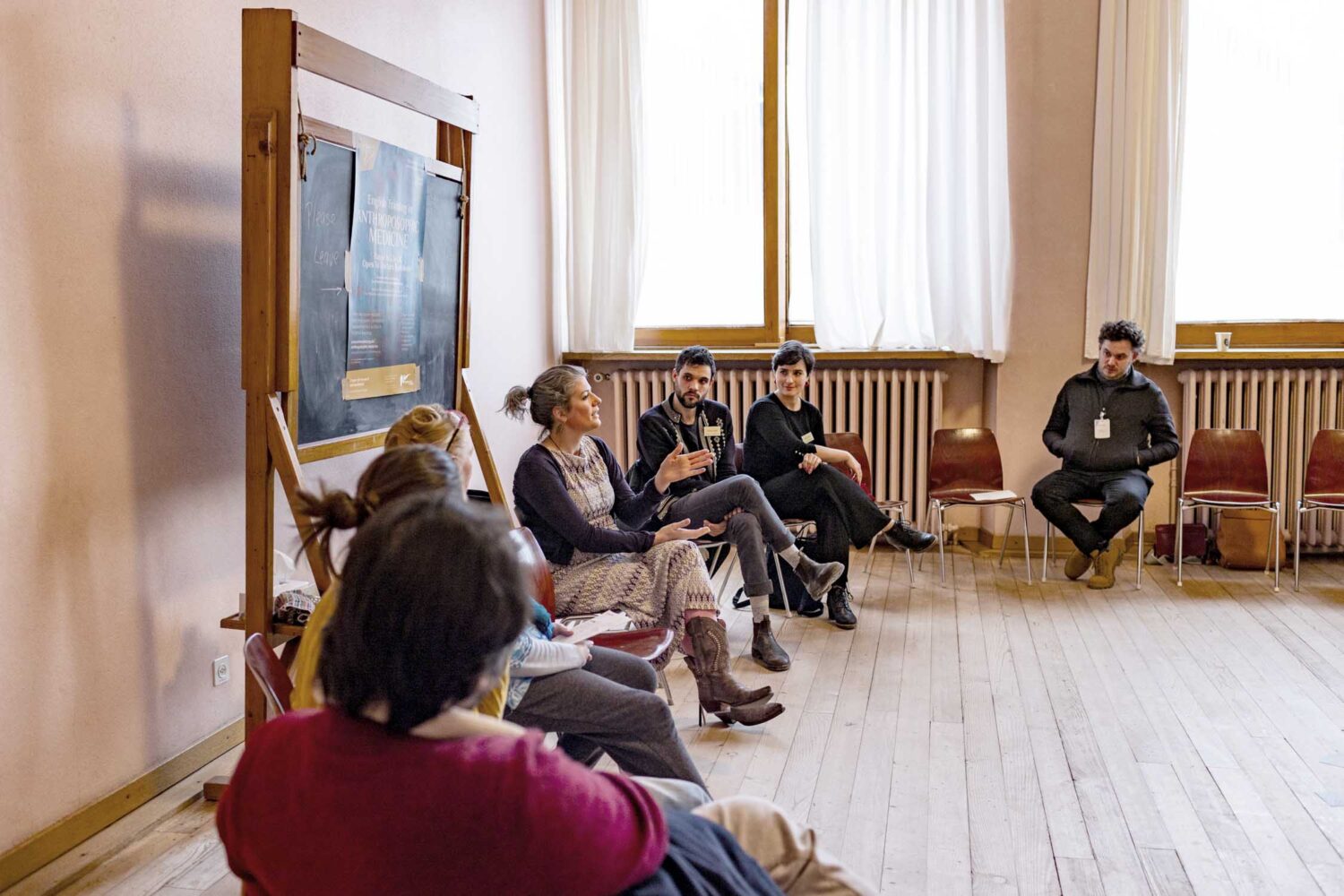
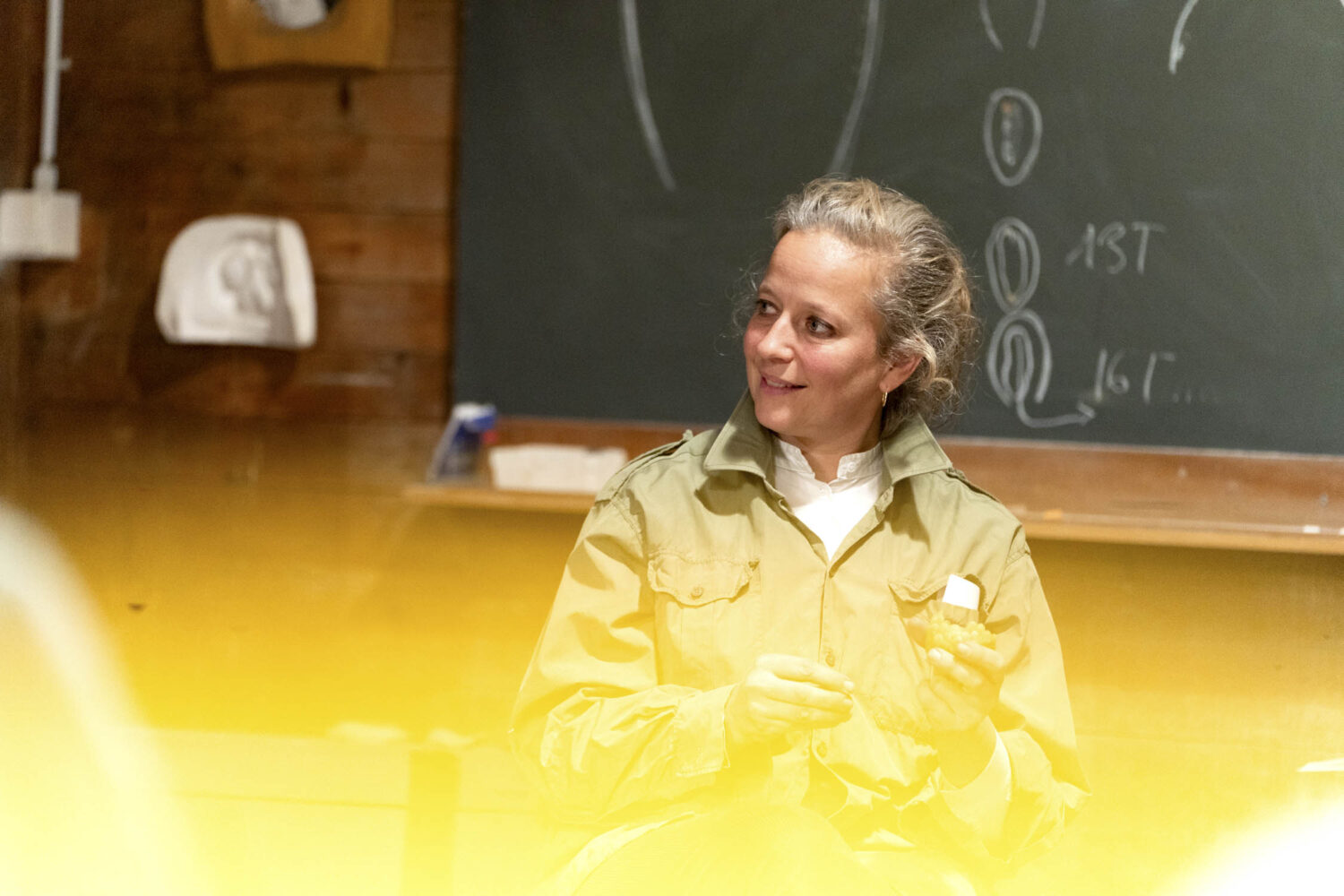
Left: Photo: Ariel Turner; right: Barbara Schnetzler, Photo: Xue Li
The following evening, Marc Desaules picks up at this point and asks: “Where is the threshold? And who is the guardian? Who speaks when the word ‘human soul’ sounds out in the Foundation Stone Meditation?” He describes the Guardian of the Threshold as an “external self” and the threshold as the place “where sensory knowledge ends.” Does this mean that I actually encounter myself in my fears and insecurities in the guardian? And what kind of knowledge lies beyond sensory experience? Is Desaules speaking here of five senses or with Steiner of ten or twelve? And can’t the spiritual world also be experienced in the purely sensory world, for example, in the free geometric flight of flocks of starlings? Aren’t such phenomena already quite close to what Christine Gruwez calls “essence”, or am I thinking too exoterically here?
Marc Desaules explains how people build a world of thought behind matter, which we use to explain phenomena. Colours become waves; matter becomes atoms—models we created that can, however, take on the character of reality. Where we need models, Desaules says, lies the spiritual world. Care had to be taken here to not confuse the house with the surrounding scaffolding because “if I enter the spiritual world with inaccurate conceptions of reality, my healthy return is jeopardised.” One possible way is not only to study anthroposophy but to live it, to help it become effective. Marc Desaules did this with his proposal to leave the financing of the conference to the individual judgement of the participants. During the conference, the Anthroposophical Society in Switzerland found itself facing a funding shortfall of CHF 100,000, which hopefully can still be covered or reduced by voluntary donations. Such gestures show how anthroposophy can be incarnated in concrete terms: with insight, courage, and a willingness to take risks. “The gods are waiting for the human being,” says Desaules. “Our will can do nothing for the big wide world, but the will of the gods can. But if we do nothing at all, the gods cannot take action either! We open the gate through which the good spirits step onto the earth. We can work with them worldwide—we hold the key in our hands.”
The almost dizzying wealth of ideas presented to me during the conference really does have the character of a Christmas present. I almost feel like those shepherds who did not know whether to be afraid or rejoice in the dark field. The decision is very easy for me during the short evening performances of the Eurythmy Stage at the Goetheanum. When I look at the traces they left behind in me, my language also wants to dance.
A piece by Anton Webern—actually, there are three, but they are connected by probing movement. How do you choreograph mindfulness? The atmosphere in the hall crackles with anticipation: when will the tones start again? The eurythmists move in a searching, hesitant, anticipatory, almost fearful manner. The silence breathes, stretches, becomes thinner, pulls at me too—then the first tone! The artist virtually picks it out of the air to then float on it. From the auditorium, I follow the apparent chaos on stage, the dissonant yet inviting sound gestures and forget that I had been holding my breath, prompted by the questioning gestures of the silent forms.
The day before, during a wild piece by Lera Auerbach, the stage quivers with energy, and I want to jump up. How bourgeois I feel sitting here in my seat while the drama unfolds ten metres in front of me! Utmost precision is required at this speed. The concentration of the performers allows the music to unfold in my soul: eyes, ears, and my kinesthetic sense are all much more actively engaged than is visible on the outside. Does everyone in the audience feel this way? What an ocean of inner movement in the main auditorium: what rages on stage surges in us under the skin. What a guest of honour music is in my soul life! And what a festive garment does eurythmy provide for it!
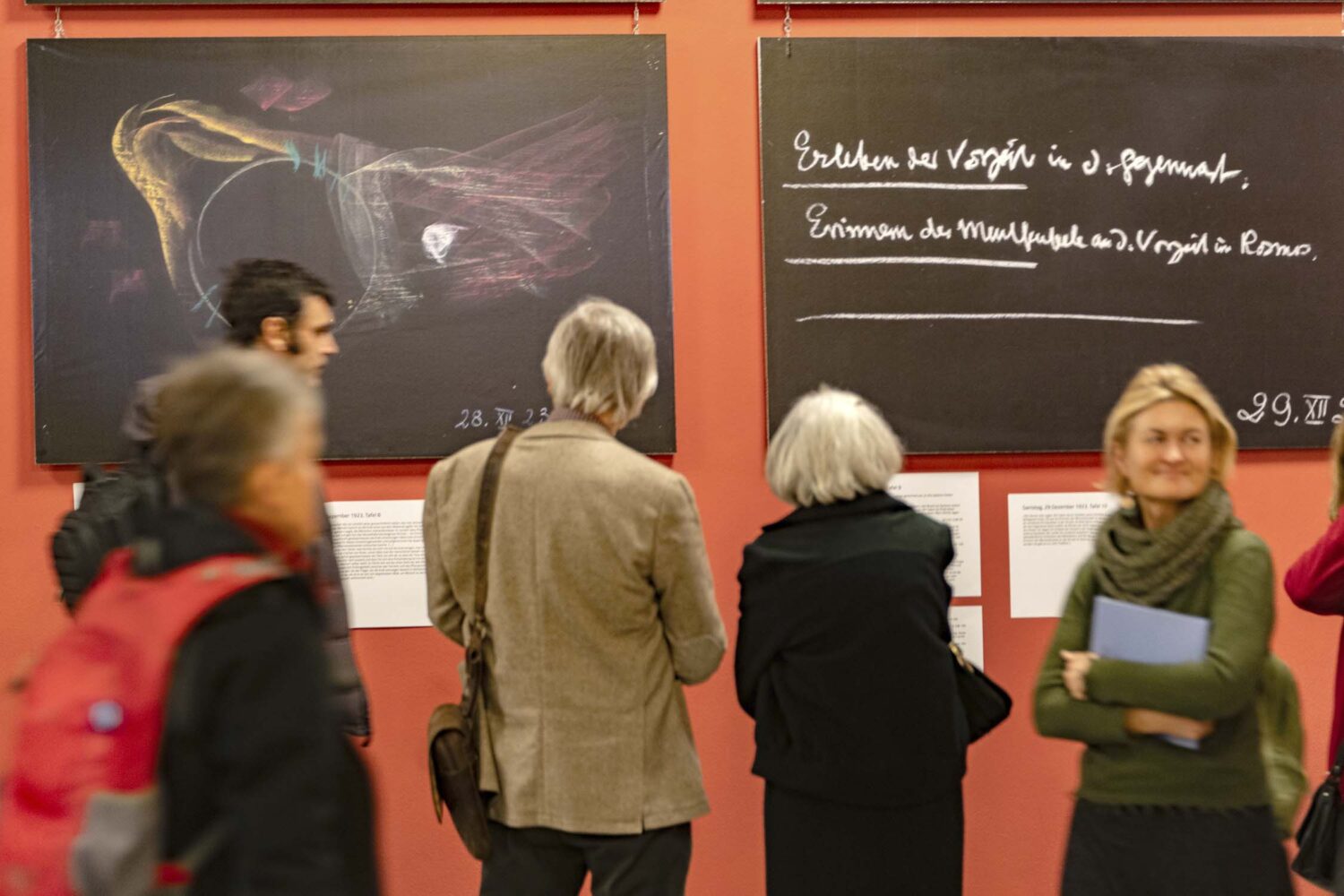

Left: Photo: Xue Li; Right: Photo: Ariel Turner
The Thirteenth Fairy
On the last day, there are many closing words and overall impressions. There is a sense that the contributors have listened carefully to each other and are now following up. Every person, Peter Selg said, brings something new here and takes something new away with them into their sphere of activity. One of his sentences strikes me to the heart: “In 1923, those listening at the time thought the world war was behind them!” But, he continues, when Steiner died, there was actually hardly anything that could give rise to hope: “A ruin in Dornach, a school at risk in Stuttgart … everything could actually have ended here. But three years later, the Goetheanum was built, and one school has now become 1,200. Despite all the internal and external difficulties, the impulse was efficiently taken up, implemented, and supported as best as was possible. […] Rudolf Steiner was a worker: born in a railway station and died in a carpentry workshop. He inspired and encouraged people to work.”
Clara Steinemann asks whether it is a karmic gift to be connected with anthroposophy. Does it impose the responsibility on me to work in a healing way in the world, to behave in such a way with others in a social and professional setting that I can carry out my work effectively and efficiently? The Dutch call for a “warmth column” seems to have found a deep echo. Many of the speakers, although biographically rooted in the “longing for cognition,” express the feeling that the future requires an “orientation towards the heart.” This is another opportunity to exchange ideas with those sitting next to me: What can I do in the coming year that “it will become good”?
Another gift is announced: on their way out, all participants will be given a copy of the newly published book in which the Foundation Stone Meditation has been translated into 40 languages. This is also an initiative from Rik ten Cate, the counterpart in thought to the artistic foundation stone. And then the thirteenth fairy enters the stage: as an unannounced brief speaker, the Erzoberlenker of the Christian Community, João Torunsky. He reminds the audience that the Christmas conference ties in with the Christian tradition of celebrating the birth of “Jesus,” but the birth of “Christ” was the baptism in Jordan, when the spirit united with its vessel. At Rudolf Steiner’s Christmas Conference in 1923/24, the vessel of the “Anthroposophical Society” was formed—a birth took place in all its solemnity. Torunsky’s simple question, “When do we celebrate the baptism?” inspires spontaneous applause. When and how does the being Anthroposophia connect with the vessel formed for it? Who would play the role of the baptist? John’s virtue was his modesty, and yet his contribution was essential. Can each and every one of us become a baptist?
Spontaneously, and out of the awareness of the “warmth column”, the participants stand up once more after the final applause and together speak the fourth stanza of the Foundation Stone verse—unplanned, disorganised, authentic, and true to the heart.
Note Much of the Christmas Conference cannot be presented in an article—that is part of the value of such a gathering. This includes the exhibitions and specialist courses, the members’ forum, and the presentation of the Goetheanum Leadership’s research work. We will pick up on the latter in subsequent issues of Das Goetheanum Weekly.
Translation Christian von Arnim
Title image The foundation stone of the first Goetheanum, formed from two copper dodecahedrons, introduced during the Christmas conference. Photo: Ariel Turner
Footnotes
- Espen Tharaldsen, “The Dream of the Third Goetheanum”, in Das Goetheanum Weekly, February 1, 2024.












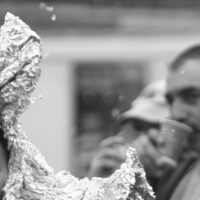

as one far away in the southern lands I am greatly moved and thankful for this wondrous written exhalation of the spoken words of those in attendance and their diverse presentation. It is an event that only those who attended can really know the inner light of seeing into the good of so many hearts from so many different lands. Oh how I wish to be there and end my days within and around the spirits of Anthroposophical wisdom. Blessings on all who attended and those of us lucky enough to share this wonderful expose with great heartfelt warmth and thanks to you Sven Saar !!!